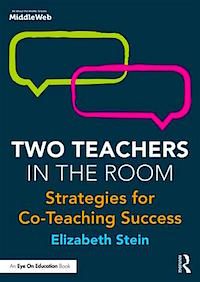Guiding Questions Can Help Co-teachers ‘Sync’
A MiddleWeb Blog
 Let’s jump right in with the context: A co-teaching pair invited me back for another round of co-teaching planning sessions. They shared their frustration with trying to engage and guide learners in their classroom to participate during class instruction.
Let’s jump right in with the context: A co-teaching pair invited me back for another round of co-teaching planning sessions. They shared their frustration with trying to engage and guide learners in their classroom to participate during class instruction.
Our co-planning time always goes well. Ideas bounce around the table with a clear sense that these teachers are truly in sync with designing instruction that creates an active learning process for every learner. Yet, there is a pattern of disconnect between the planning and implementation phase.
Our debriefing sessions are also showing consistent patterns. The teachers ask themselves: What went wrong? Why were too many students still inactive? Why do we still have the same students participating, while most of the class remains quiet? Yet, the energizing planning sessions cannot be ignored.
These teachers have a clear desire to co-create a student-centered learning environment – yet, classroom experiences are not yet unfolding in this desired direction.
Although this is not a quick fix, we can consider a few questions to guide the reflective process toward greater student engagement and participation. Co-teachers need to begin to dig deeper into revealing their underlying assumptions about teaching and learning.
Here are examples of some of the guiding questions for co-teachers to consider.
The PURPOSE of learning
In general, what is the purpose of school? Is it to cultivate critical thinkers? Is it to prepare them for a successful career in the workforce? Could it be both?
How is knowledge gained and validated? Teachers should consider the messages they are sending to their students. Are we guiding students to construct necessary content knowledge – and also guiding students to personally connect with why this knowledge is important to know in the first place?
If knowledge is simply gained and legitimized by the results of an assignment or test, how does this serve the student’s meaningful connection to the information?
Who has access to knowledge and how is it distributed in the classroom? As co-teachers how can we inspire/encourage students to embrace the content in ways that ensure every learner has the opportunity perceive the content in meaningful ways?
Possible Solutions:
As co-teachers design instruction to allow students to embrace multiple ways of knowing, students will be engaging with the awareness that their interpretation and level of understanding is valued.
Consider the seating arrangements to allow for seamless and spontaneous peer collaborations and small group discussions in the midst of whole class instructional time.
The PROCESS of learning
Review your goal for the learning environment: Continue to emphasize the WHY of learning in your room and then connect with robust options of HOW they may go about learning.
Make reflection a critical part of the process.
Possible Solutions:
In addition to co-teachers debriefing outside of class time, students should be a part of this reflective process. Just as we want to provide multiple ways of knowing, we want to include multiple ways of assessing what students know. This could include journaling, classroom dialogue, and think-pair-share opportunities, along with options for creative expressions.
Observing the guiding questions in practice
These are some of the questions that guided the co-teaching pair mentioned at the beginning of this post to begin to answer their own concerns about how to convince more students to take a part in the learning process. Their candid responses resulted in the awareness that their underlying assumptions were getting in the way of ‘syncing’ as a team!
For example, when identifying the purpose of teaching (and school in general), one of the co-teachers shared the desire to get his students ready for tests and graduation requirements. The other co-teacher admitted she had lost her focus and joined in her co-teacher’s assumptions.
When discussing what the process of learning looks like in comparison with what they wish it would look like, both co-teachers agreed that although they plan for student-centered learning, they fall into the ways of teacher-centered learning because they feel it better supports their goal to get students ready for testing and graduation requirements.
For these two teachers, this revelation may be the pivotal moment in acting upon their desire to co-create a more learner-centered environment where students find purpose and meaning in their education.
How has this philosophical look into practical classroom practice resonated with you? What are your underlying assumptions about teaching and learning that serve to create your current classroom experiences with your students? Please share below!
And also start a Twitter conversation using the hashtag #CoTeachat. These very conversations are what will lead to critical action steps—let’s do this!
________________________________________________________




































